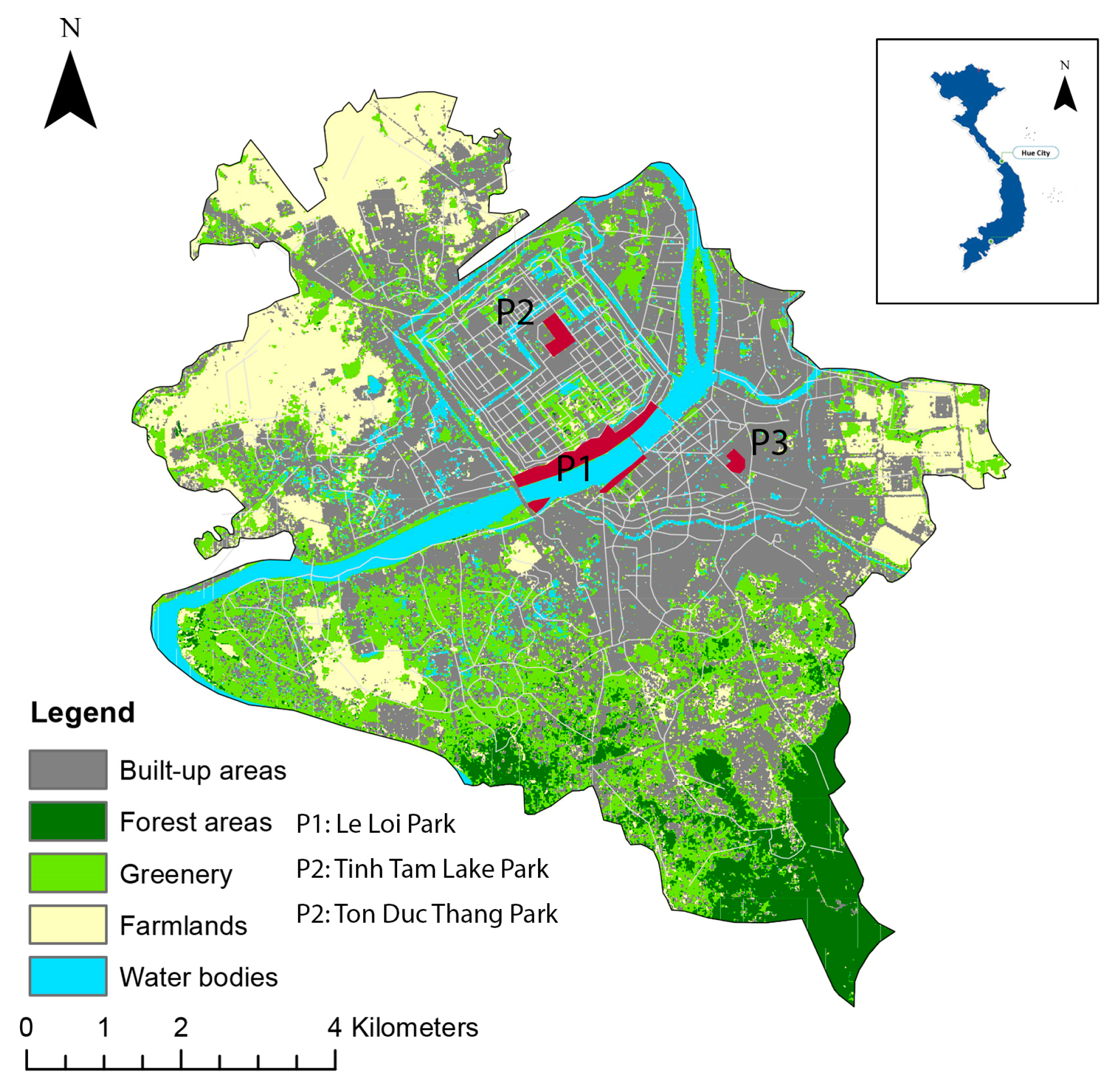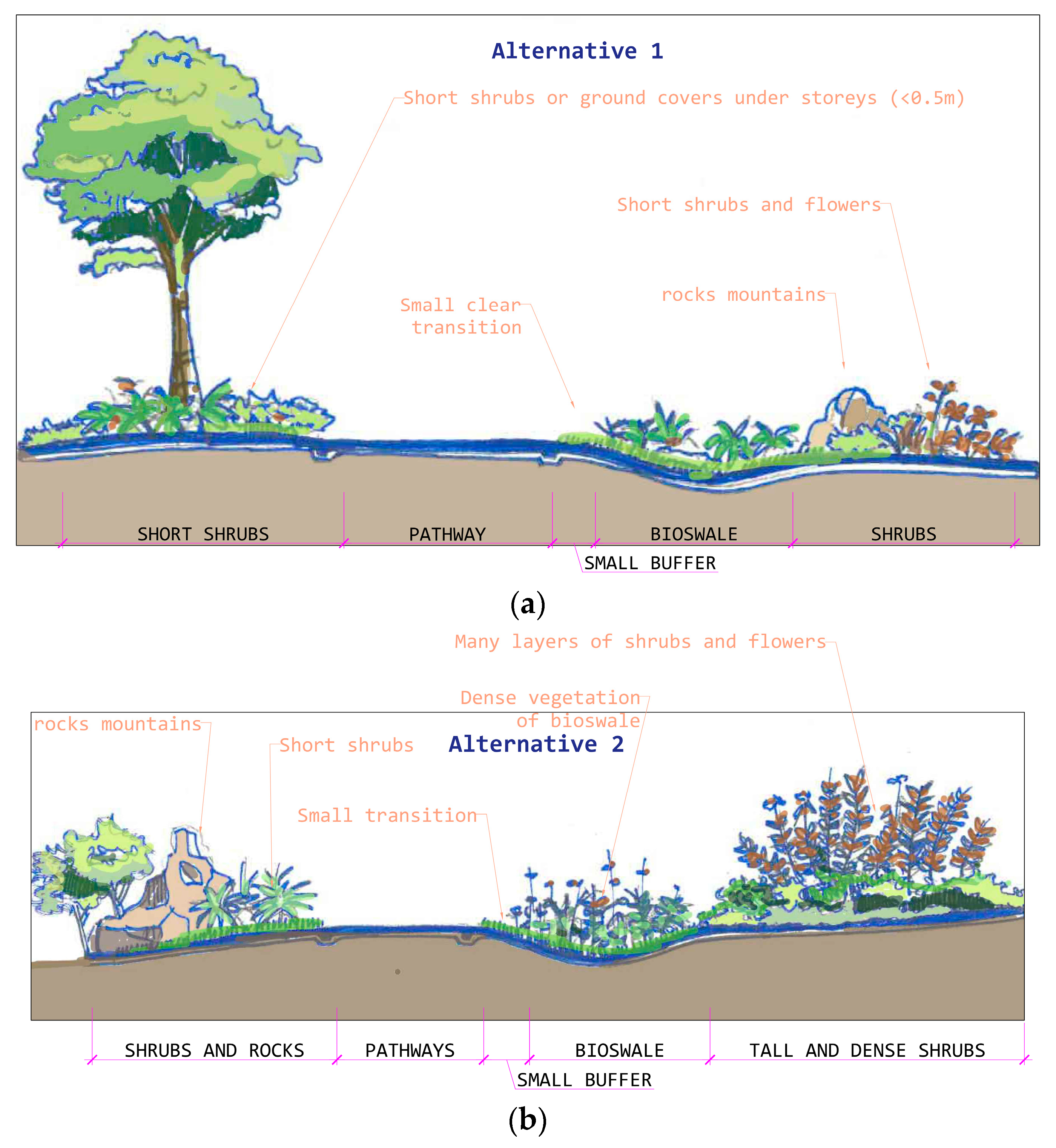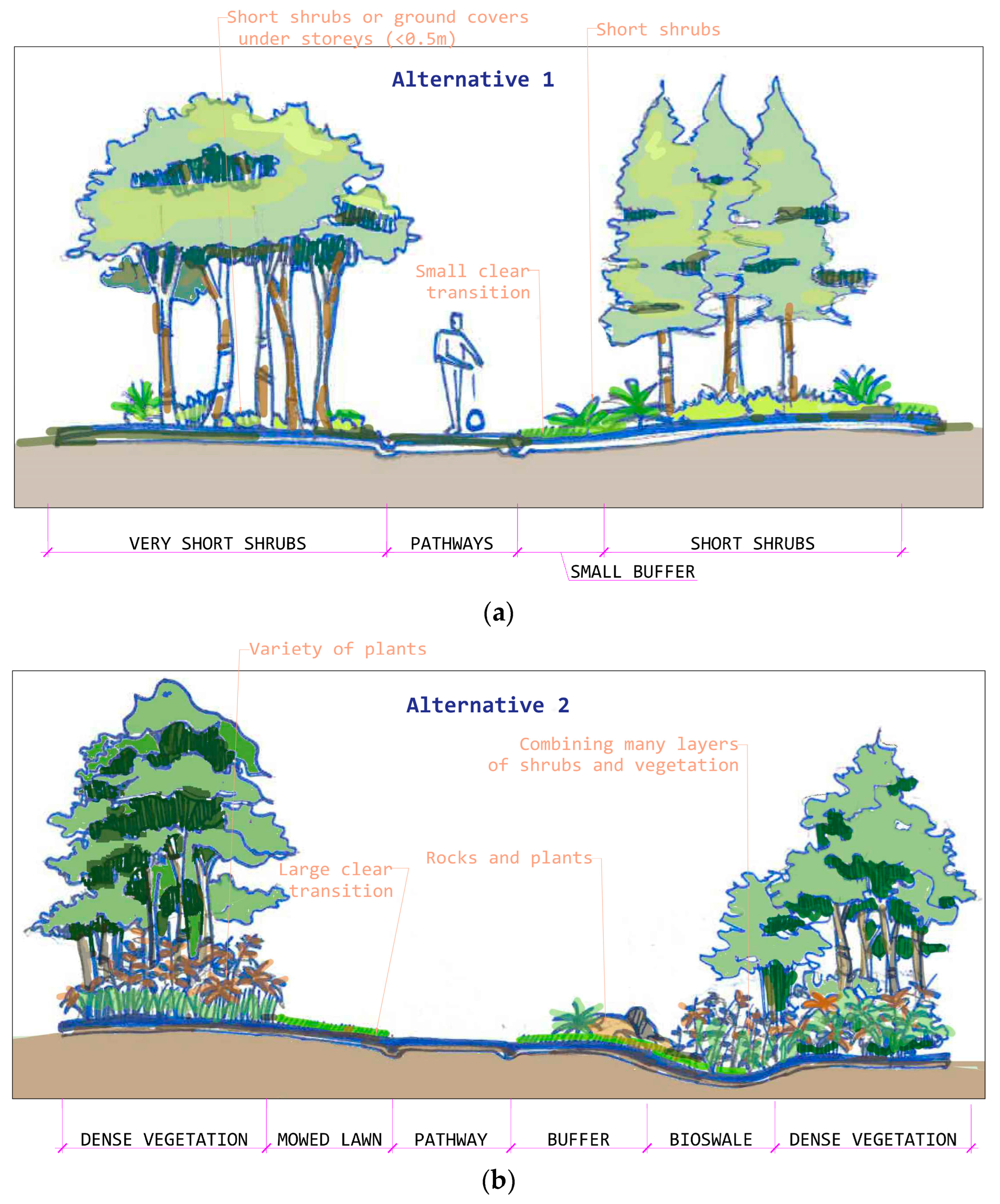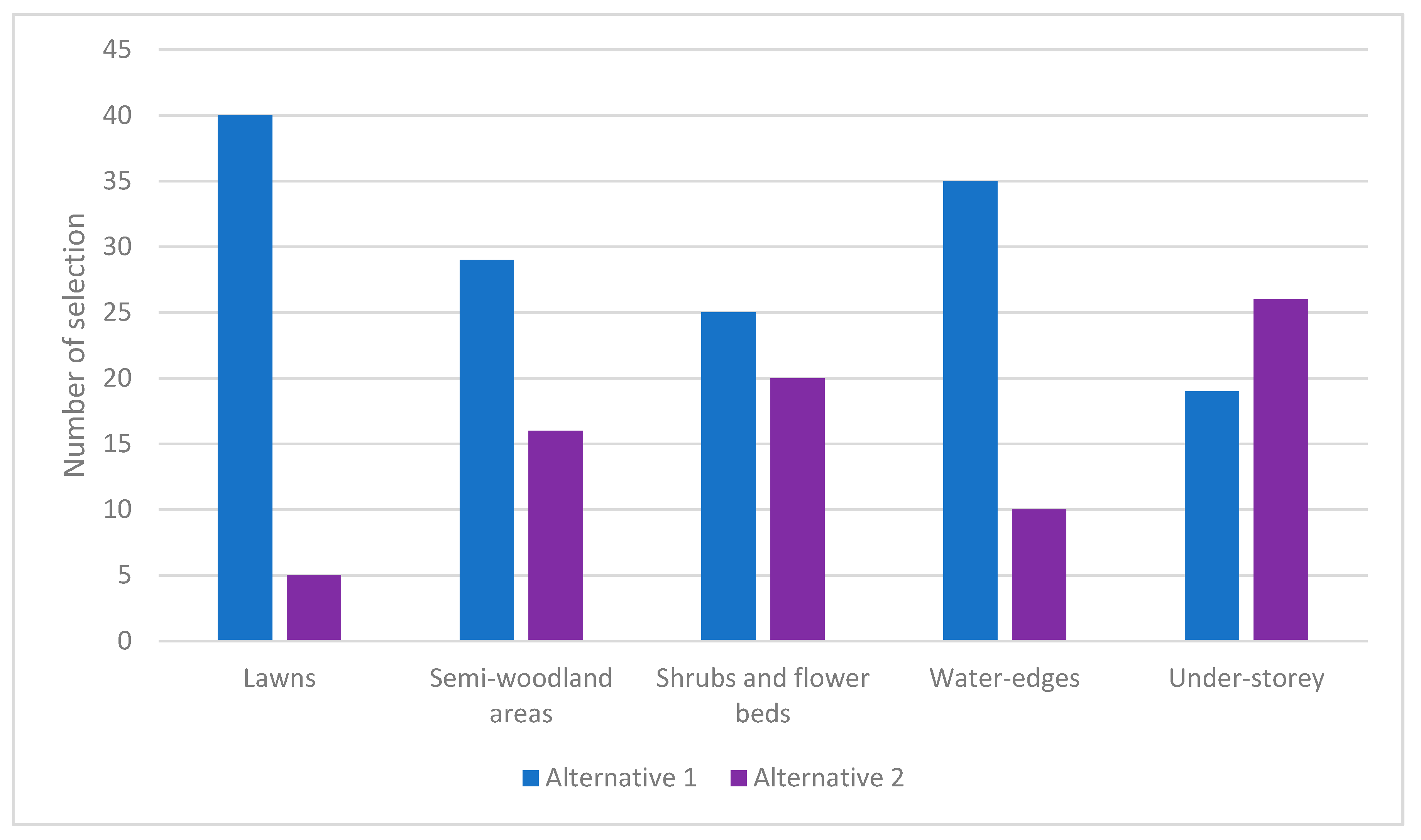Challenges and Stakeholder Perspectives on Implementing Ecological Designs in Green Public Spaces: A Case Study of Hue City, Vietnam
Abstract
:1. Introduction
Urban Green Spaces in Vietnam
2. Materials and Methods
2.1. Case Study
2.2. Semi-Structured Interview with the Assistance of Designed Images
3. Results
3.1. Theme 1: Challenges of Implementing Ecological Design in Public Green Spaces
3.1.1. Insufficient Understanding and Priority Are Given to Ecosystem Services
3.1.2. Concerning Responses from the Market Demands
3.1.3. Motivation and Collaboration among Departments
3.2. Theme 2: Stakeholder Perspectives on the Implementation of Ecological Design Scenarios
3.2.1. Maintenance Tasks and Programs
3.2.2. Park Safety and Security
3.2.3. Visual Appearance
4. Discussion
4.1. Appropriate Ecological Landscape in the Eye of Stakeholders
4.2. Recommendations to Address the Challenges in Implementing Ecological Designs
5. Conclusions
Author Contributions
Funding
Institutional Review Board Statement
Data Availability Statement
Acknowledgments
Conflicts of Interest
Appendix A. Semistructured Interview Questions
References
- Çelik, F. Ecological Landscape Design. In Advances in Landscape Architecture; Özyavuz, M., Ed.; IntechOpen: Rijeka, Croatia, 2013; p. 13. [Google Scholar]
- Gültekın, H. Ecological Design And Retrieving The Environmental Meaning. In Memory in the Ontopoiesis of Life: Book One. Memory in the Generation and Unfolding of Life; Tymieniecka, A.-T., Ed.; Springer: Dordrecht, The Netherlands, 2009; pp. 73–79. ISBN 978-90-481-2501-2. [Google Scholar]
- Bolund, P.; Hunhammar, S. Ecosystem services in urban areas. Ecol. Econ. 1999, 30, 293–301. [Google Scholar] [CrossRef]
- Bastian, O.; Haase, D.; Grunewald, K. Ecosystem properties, potentials and services—The EPPS conceptual framework and an urban application example. Ecol. Indic. 2012, 21, 7–16. [Google Scholar] [CrossRef]
- Larondelle, N.; Haase, D. Urban ecosystem services assessment along a rural–urban gradient: A cross-analysis of European cities. Ecol. Indic. 2013, 29, 179–190. [Google Scholar] [CrossRef]
- Chou, W.-Y.; Lee, C.-H.; Chang, C.-Y. Relationships between urban open spaces and humans’ health benefits from an ecological perspective: A study in an urban campus. Landsc. Ecol. Eng. 2016, 12, 255–267. [Google Scholar] [CrossRef]
- Melchionni, B. Integrating Ecological and Human Health: Restorative Environmental Design in Therapeutic Landscapes. Ph.D Thesis, University of Georgia, Athens, GA, USA, 2021. [Google Scholar]
- Danler, S.; Langellotto-Rhodaback, G. Ecological Design of Urban Landscapes: Economic, Social, and Ecological Benefits; Oregon State University: Corvallis, OR, USA, 2015; Available online: https://catalog.extension.oregonstate.edu/em9107/html (accessed on 11 March 2023).
- Wu, J.J. Public open-space conservation under a budget constraint. J. Public Econ. 2014, 111, 96–101. [Google Scholar] [CrossRef]
- Berthon, K.; Thomas, F.; Bekessy, S. The role of ‘nativeness’ in urban greening to support animal biodiversity. Landsc. Urban Plan. 2021, 205, 103959. [Google Scholar] [CrossRef]
- Shu-Yang, F.; Freedman, B.; Cote, R. Principles and practice of ecological design. Environ. Rev. 2004, 12, 97–112. [Google Scholar] [CrossRef]
- Fletcher, T.D.; Shuster, W.; Hunt, W.F.; Ashley, R.; Butler, D.; Arthur, S.; Trowsdale, S.; Barraud, S.; Semadeni-Davies, A.; Bertrand-Krajewski, J.L.; et al. SUDS, LID, BMPs, WSUD and more—The evolution and application of terminology surrounding urban drainage. Urban Water J. 2015, 12, 525–542. [Google Scholar] [CrossRef]
- Konijnendijk, C.C.; Annerstedt, M.; Nielsen, A.B.; Maruthaveeran, S. Benefits of Urban Parks—A systematic review. Int. Fed. Park. Recreat. Adm. 2013, 1–68. [Google Scholar]
- Vargas-Hernández, J.G.; Pallagst, K.; Zdunek-Wielgołaska, J. Urban green spaces as a component of an ecosystem. In Handbook of Engaged Sustainability; Springer: Cham, Swizerland, 2018; pp. 885–916. [Google Scholar] [CrossRef]
- Jasmani, Z. Small urban parks and resilience theory: How to link human patterns and ecological functions for urban sustainability. Urban Ecol. Sci. Cult. Power Course 2013, 1–11. [Google Scholar]
- Swanwick, C.; Dunnett, N.; Woolley, H. Nature, role and value of green space in towns and cities: An overview. Built Environ. 2003, 29, 94–106. [Google Scholar] [CrossRef]
- Graça, M.; Alves, P.; Gonçalves, J.; Nowak, D.J.; Hoehn, R.; Farinha-Marques, P.; Cunha, M. Assessing how green space types affect ecosystem services delivery in Porto, Portugal. Landsc. Urban Plan. 2018, 170, 195–208. [Google Scholar] [CrossRef]
- Nowak, D.J.; Dwyer, J.F. Understanding the Benefits and Costs of Urban Forest Ecosystems BT—Handbook of Urban and Community Forestry in the Northeast. In Urban and Community Forestry in the Northeast; Kuser, J.E., Ed.; Springer: Boston, MA, USA, 2000; pp. 11–25. ISBN 978-1-4615-4191-2. [Google Scholar]
- Gibson, D.R.; Rowe, L.; Isaacs, R.; Landis, D.A. Screening Drought-Tolerant Native Plants for Attractiveness to Arthropod Natural Enemies in the U.S. Great Lakes Region. Environ. Entomol. 2019, 48, 1469–1480. [Google Scholar] [CrossRef]
- Ignatieva, M.; Haase, D.; Dushkova, D.; Haase, A. Lawns in cities: From a globalised urban green space phenomenon to sustainable nature-based solutions. Land 2020, 9, 73. [Google Scholar] [CrossRef]
- MEA. Ecosystems and Human Well-Being: A Report on the Conceptual Framework Working Group of the Millenium Ecosystem Assessment; MEA: Beirut, Lebanon, 2005; Volume 5, ISBN 1559634022. [Google Scholar]
- Lovell, S.T.; Johnston, D.M. Designing landscapes for performance based on emerging principles in landscape ecology. Ecol. Soc. 2009, 14, 44. [Google Scholar] [CrossRef]
- Nastran, M.; Pintar, M.; Železnikar, Š.; Cvejić, R. Stakeholders’ Perceptions on the Role of Urban Green Infrastructure in Providing Ecosystem Services for Human Well-Being. Land 2022, 11, 299. [Google Scholar] [CrossRef]
- Molla, M.B. The Value of Urban Green Infrastructure and Its Environmental Response in Urban Ecosystem: A Literature Review. Int. J. Environ. Sci. 2015, 4, 89–101. [Google Scholar]
- Cranz, G.; Boland, M. Defining the Sustainable Park: A Fifth Model for Urban Parks. Landsc. J. 2004, 23, 102–120. [Google Scholar] [CrossRef]
- Chiesura, A. The role of urban parks for the sustainable city. Landsc. Urban Plan. 2004, 68, 129–138. [Google Scholar] [CrossRef]
- Biodiversity Information System for Europe, Green Infrastructure. 2016. Available online: https://biodiversity.europa.eu/countries/spain/green-infrastructure (accessed on 6 September 2023).
- Ahern, J. Urban landscape sustainability and resilience: The promise and challenges of integrating ecology with urban planning and design. Landsc. Ecol. 2013, 28, 1203–1212. [Google Scholar] [CrossRef]
- Beller, E.; Robinson, A.; Grossinger, R.; Grenier, L. Landscape Resilience Operationalizing Ecological; San Francisco Estuary Institute: Richmond, CA, USA, 2015. [Google Scholar]
- Gunderson, L.H. Ecological Resilience—In Theory And Application. Annu. Rev. 2000, 31, 425–439. [Google Scholar] [CrossRef]
- Calkins, M. Strategy use and challenges of ecological design in landscape architecture. Landsc. Urban Plan. 2005, 73, 29–48. [Google Scholar] [CrossRef]
- Hagemann, F.A.; Randrup, T.B.; Sang, Å.O. Challenges to implementing the urban ecosystem service concept in green infrastructure planning: A view from practitioners in Swedish municipalities. Socio-Ecol. Pract. Res. 2020, 2, 283–296. [Google Scholar] [CrossRef]
- Nassauer, J.I. Messy Ecosystems, Orderly Frames. Landsc. J. 1995, 14, 161–170. [Google Scholar] [CrossRef]
- Nassauer, J.I. The aesthetics of horticulture: Neatness as a Form of Care. HortScience 1988, 23, 973–977. [Google Scholar] [CrossRef]
- Hostetler, M. Cues to Care: Are City landowners Willing to Make Eco-Friendly Landscapes. 2018. Available online: https://www.thenatureofcities.com/2018/08/24/cues-care-city-landowners-willing-make-eco-friendly-landscapes/ (accessed on 9 June 2022).
- Hoyle, H.; Jorgensen, A.; Warren, P.; Dunnett, N.; Evans, K. “Not in their front yard” The opportunities and challenges of introducing perennial urban meadows: A local authority stakeholder perspective. Urban For. Urban Green. 2017, 25, 139–149. [Google Scholar] [CrossRef]
- Nassauer, J.I.; Wang, Z.; Dayrell, E. What will the neighbors think? Cultural norms and ecological design. Landsc. Urban Plan. 2009, 92, 282–292. [Google Scholar] [CrossRef]
- Ibrahim, R.; Clayden, A.; Cameron, R. Tropical urban parks in Kuala Lumpur, Malaysia: Challenging the attitudes of park management teams towards a more environmentally sustainable approach. Urban For. Urban Green. 2020, 49, 126605. [Google Scholar] [CrossRef]
- Primmer, E.; Furman, E. Operationalising ecosystem service approaches for governance: Do measuring, mapping and valuing integrate sector-specific knowledge systems? Ecosyst. Serv. 2012, 1, 85–92. [Google Scholar] [CrossRef]
- Nguyen, T.T.T. Kiến Trúc Phong Cảnh [Garden Landscape Architecture]; Scientific and Technical Publisher: Hanoi, Vietnam, 1996. [Google Scholar]
- Söderström, O.; Geertman, S. Loose threads: The translocal making of public space policy in Hanoi. Singap. J. Trop. Geogr. 2013, 34, 244–267. [Google Scholar] [CrossRef]
- WWF, Hue is the First City in Vietnam Recognized for Its Commitment to Low-Carbon Development. 2016. Available online: https://wwf.panda.org/wwf_news/?271991/hue-first-city-vietnam-recognized-commitment-low-carbon#:~:text=Hue%20%E2%80%93%2028%20June%202016%20%E2%80%93%20WWF,become%20leaders%20in%20sustainable%20development (accessed on 3 March 2023).
- COMMITTEE, T.C.S. Politburo’s Resolution on Building and Development of Thua Thien Hue by 2030 with Vision toward 2045. 2019. Available online: https://lawnet.vn/en/vb/Politburo-s-Resolution-54-NQ-TW-2019-building-and-development-of-Thua-Thien-Hue-by-2030-6F0B5.html (accessed on 3 March 2023).
- Crowe, S.; Cresswell, K.; Robertson, A.; Huby, G.; Avery, A.; Sheikh, A. The case study approach. BMC Med. Res. Methodol. 2011, 11, 100. [Google Scholar] [CrossRef]
- Nassauer, J.I. Cultural Sustainability: Aligning Aesthetics and Ecology. In Placing Nature: Culture and Landscape Ecology; Island Press: Washington, DC, USA, 1997; pp. 67–83. [Google Scholar]
- Jorgensen, A.; Hitchmough, J.; Calvert, T. Woodland spaces and edges: Their impact on perception of safety and preference. Landsc. Urban Plan. 2002, 60, 135–150. [Google Scholar] [CrossRef]
- Harris, V.; Kendal, D.; Hahs, A.K.; Threlfall, C.G. Green space context and vegetation complexity shape people’s preferences for urban public parks and residential gardens. Landsc. Res. 2018, 43, 150–162. [Google Scholar] [CrossRef]
- Shih, W.Y.; Mabon, L. Urban growth, green infrastructure loss and spatial inequity under climate change in Hanoi, Vietnam. In Routledge Handbook Urban Ecology, 2nd ed.; Taylor & Francis Group: Blackpool, UK, 2020; pp. 1007–1025. [Google Scholar] [CrossRef]
- USAID. Vietnam Climate Change Fact Sheet; USAID: Washington, DC, USA, 2021; pp. 1–3.
- Southon, G.E.; Jorgensen, A.; Dunnett, N.; Hoyle, H.; Evans, K.L. Biodiverse perennial meadows have aesthetic value and increase residents’ perceptions of site quality in urban green-space. Landsc. Urban Plan. 2017, 158, 105–118. [Google Scholar] [CrossRef]
- Trong Cuc, L. Vietnam: Traditional cultural concepts of human relations with the nature. Asian Geogr. 2011, 5706, 67–74. [Google Scholar] [CrossRef]
- Labbé, D.; Herbelin, C.; Vinh, D.Q. Colonial Hanoi. In Harbin to Hanoi: Architectural Production and Exchanges in Hanoi during the Late French Colonial Era; Hong Kong University Press: Hong Kong, China, 2014; Chapter 10; pp. 206–226. [Google Scholar]
- Ignatieva, M. Design and Future of Urban Biodiversity. Urban Biodivers. Des. 2010, Chapter 6, 118–144. [Google Scholar] [CrossRef]
- UNEP A City in a Garden: ‘A City in a Garden’: Singapore’s Journey to Becoming a Biodiversity Model. 2018. Available online: https://www.unep.org/news-and-stories/story/city-garden-singapores-journey-becoming-biodiversity-model (accessed on 20 April 2023).










| Participant | Expertise | |
|---|---|---|
| Senior park manager | P1 | Architect |
| Senior park manager | P2 | Agricultural engineer |
| Senior park manager | P3 | Agricultural and forestry engineer |
| Park site supervisor | P4 | Agricultural engineer |
| Park site supervisor | P5 | Architect |
| Park site supervisor | P6 | Horticultural engineer |
| Park site supervisor | P7 | Agricultural engineer |
| Ground staff | P8 | Horticultural worker |
| Ground staff | P9 | Horticultural worker |
| Ground staff | P10 | Horticultural worker |
| Landscape architect | P11 | Landscape design |
| Landscape architect | P12 | Landscape design |
| Landscape architect | P13 | Landscape design |
| Academic scholar | P14 | Urban design and management |
| Academic scholar | P15 | Urban design and management |
| Total | 15 | |
Disclaimer/Publisher’s Note: The statements, opinions and data contained in all publications are solely those of the individual author(s) and contributor(s) and not of MDPI and/or the editor(s). MDPI and/or the editor(s) disclaim responsibility for any injury to people or property resulting from any ideas, methods, instructions or products referred to in the content. |
© 2023 by the authors. Licensee MDPI, Basel, Switzerland. This article is an open access article distributed under the terms and conditions of the Creative Commons Attribution (CC BY) license (https://creativecommons.org/licenses/by/4.0/).
Share and Cite
Ignatieva, M.; Tran, D.K.; Tenorio, R. Challenges and Stakeholder Perspectives on Implementing Ecological Designs in Green Public Spaces: A Case Study of Hue City, Vietnam. Land 2023, 12, 1772. https://doi.org/10.3390/land12091772
Ignatieva M, Tran DK, Tenorio R. Challenges and Stakeholder Perspectives on Implementing Ecological Designs in Green Public Spaces: A Case Study of Hue City, Vietnam. Land. 2023; 12(9):1772. https://doi.org/10.3390/land12091772
Chicago/Turabian StyleIgnatieva, Maria, Duy Khiem Tran, and Rosangela Tenorio. 2023. "Challenges and Stakeholder Perspectives on Implementing Ecological Designs in Green Public Spaces: A Case Study of Hue City, Vietnam" Land 12, no. 9: 1772. https://doi.org/10.3390/land12091772
APA StyleIgnatieva, M., Tran, D. K., & Tenorio, R. (2023). Challenges and Stakeholder Perspectives on Implementing Ecological Designs in Green Public Spaces: A Case Study of Hue City, Vietnam. Land, 12(9), 1772. https://doi.org/10.3390/land12091772






